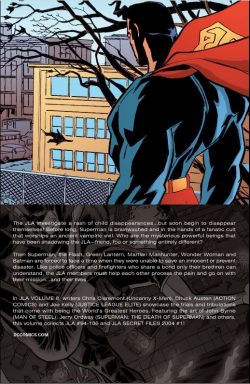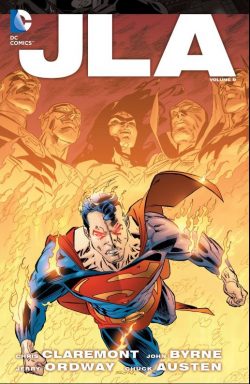

By Chris Claremont, Chuck Austen, Joe Kelly, John Byrne, Ron Garney, Doug , Jerry Ordway, Tom Nguyen & various (DC Comics)
ISBN: 978-1-4012-6342-3 (TPB)
When the Justice League of America – driving force and cornerstone of the Silver Age of Comics – were relaunched in 1997, the sheer bravura quality of the stories propelled the series back to the forefront of industry attention, making as many new fans as it recaptured old ones. However, fans are fickle and the intoxicating sheen of “fresh and new†never lasts. By the time of these tales – spanning May to November 2004 from JLA #94-106 plus material from JLA Secret Files 2004 #1 – there had been numerous changes of creative personnel… usually a bad omen… and a certain straying from the clear missions of the earliest adventures…
As you’ve come to expect by now, this volume is available in all digital formats as well as traditional trade paperback…
After battling all manner of contemporary and futuristic foes, in ‘Suffer the Little Children’ the World’s Greatest Superheroes now find themselves pitted against an ancient malevolence from out of Earth’s oldest nightmares. Contrived by a trio of the industry’s biggest talents – Chris Claremont, John Byrne & Jerry Ordway – the expansive saga originally ran in issues #94-99 of the monthly title.
When team mystic Manitou Raven divines that a great evil has come hunting, he is suddenly silenced before he can warn his comrades. As Batman and Flash follow a rash of global child disappearances, Superman is astonishingly defeated by a pair of strange juvenile runaways.
Comparing notes with other JLA members the heroes discover a pattern of metagenic abductions: someone or something is taking super-powered children…
Meanwhile an enthralled Man of Steel has become the slave – and ambulatory lunchbox – of diabolical vampire lord Crucifer, whose race of undying leeches has been secretly working to conquer the world since their initial defeat and extra-dimensional banishment by the Amazon warriors of Themyscira thousands of years previously.
‘The Enemy Within’ sees team boffin The Atom lost in a microverse within a magic artefact and meeting a lost race with a hidden connection to the crisis, even as a mysterious third force of freaks maneuverers for advantage in the background. When Wonder Woman consults ancient scroll records she is betrayed and attacked by her closest ally and the crucial data is erased…
As the beleaguered and outclassed heroes strive to cope, ‘The Heart of the Matter’ sees Martian Manhunter use his unique gifts to trace the Atom, but even as master tactician Batman works to counter the infallible plans of their hidden enemy, his ace in the hole Faith falls to Crucifer’s power…
And in the background, that shady band of outcasts undertakes their own plan to save the day…
‘Interludes on the Last Day of the World!’ sees the vampire resurgence edge ever closer. With Crucifer’s abducted metahuman victims acting as shock troops and physical hosts for the bloodsucking arcane exiles, the embattled remnants of the JLA reconsolidate and ally themselves with the skulking outsiders watching them, just as the vampire lord opens a hole into hell and bids his kin to freely enter…
The fightback begins in ‘Convergence’ with the rescue of the Atom whose fresh data provides the answer to the mystery of Crucifer’s seeming invulnerability, leading to a mass assault and ultimate victory by the competing teams of heroes in ‘Heartbreaker!’
The former X-Men creative team supreme reunited for this supernatural romp, but their old magic was sorely lacking: Byrne co-writing with Claremont and pencilling for the criminally underappreciated Jerry Ordway to ink and embellish is a far better “look†than “readâ€.
Comic fans love these sorts of nostalgia stunts, but sadly, the results here don’t really live up to expectations, resulting in a competent but predictable heroes-versus-vampires yarn that suffers greatly because it’s painfully obvious that the whole thing is a high-profile, extended gimmick designed to kick-start Byrne’s then-forthcoming reinvention of the Doom Patrol, and not really a JLA story at all…
Most comic books – indeed all popular fiction – are a product of or reaction to the times in which they are created. In the grim, authoritarian, morally ambiguous climate of post 9-11 America writer Joe Kelly wrote an issue of Action Comics (#775) addressing the traditional ethics and practices of ultimate boy scout Superman in a world where old values were seen as a liability and using “The Enemy’s†own tactics against them was viewed with increasing favour by the public.
‘What’s So Funny about Truth, Justice and the American Way’ (not included here) introduced super-Esper Manchester Black and his team of Elite metahumans who responded proactively and with extreme overkill to global threats and menaces in such a drastic and final manner that Superman was forced to take a long, hard look at his core beliefs before triumphing over a team who saw absolutely no difference between villains, monsters or people who disagreed with them…
In a distressing sign of those times, The Elite proved so overwhelmingly popular that they returned in JLA #100. ‘Elitism’ – by Kelly, Doug Mahnke & Tom Nguyen – depicts how the team, led now by Black’s cyborg sister Vera, at first oppose and eventually cooperate with the traditionally-minded JLA to save Earth from a catastrophic ecological and metaphysical meltdown – but all is not as it seems…
Vera Black correctly assesses the fundamental flaws in her methodology but also similar weaknesses in the JLA’s. She proposes becoming the League’s “Black Ops†division, gathering intel, working undercover and decisively dealing with potential threats before they become global crises. Her team will get their hands dirty in a way the JLA simply cannot afford to…
Over Superman’s protests, but with stringent oversight in place and using a combination of Elite and League volunteers, the plan is adopted and Justice League Elite subsequently won their own 12-issue series with Major Disaster, Green Arrow, Manitou Raven, and Flash joining Vera, energy manipulator Coldcast, human bio-weapon arsenal Menagerie and Naif al-Sheikh (a human spymaster who acts as): Director, Adjudicator and Conscience for a unit designed to neutralise organizations and nations that threaten World Security before things ever reach a boiling point.
JLA Secret Files 2004 develops the controversial theme in ‘Same Coin’, by Kelly, Byrne, Mahnke & Nguyen, wherein the two teams work separately – and mostly at odds – to stop a Hitlerian Ragnarok from occurring thanks to illicit use of mystic doomsday weapon the Spear of Destiny…
Getting over a post-celebration hump is always tricky for a long-running comic series. An anniversary or centenary is usually celebrated by some large-scale cosmos-shaking exploit which it’s impossible to top, leading to an anti-climactic “day in the life†venture. In the case of story arc Pain of the Gods – reprinting JLA #101-106 – Chuck Austen & Ron Garney take that hoary tradition, and indeed the equally tired plot of heroes’ soul-searching angst after a failure to succeed, and run with it to produce a stirring, potent exploration of humanity too often absent in modern adventure fiction.
Each chapter deals with an emotional crisis affecting an individual Leaguer who fails to save a life, beginning with Superman in ‘Man of Steel’ as the perfect hero misjudges the abilities of a new costumed champion and witnesses the wannabe hero perish in explosive conflagration…
‘Scarlet Speedster’ treads similar ground as Flash misses two children whilst evacuating a burning building and Green Lantern misjudges the homicidal determination of a domestic abuser in ‘Emerald Gladiator’. Throughout each of these tragedies a single family reappears; fuelling the emotional turmoil pushing each hero into obsession and psychosis.
In ‘Manhunter from Mars’ team telepath and philosophical lynchpin J’onn J’onzz is forced to confront the life-long emotional barriers distancing him from his companions and resulting from surviving the death of his entire species, whilst Wonder Woman faces her own mortality whilst battling a super-killer in ‘Amazonian Warrior’ before Batman ultimately must acknowledge that he can’t know and do everything alone in ‘The Dark Knight’…
The entire story can be viewed as a treatise on fallibility and post-traumatic distress with superheroes acting as metaphors for Police and Firemen, and the cleverly-inserted sub-plot of a seemingly mundane family seeking redress plays well against the tragic grandeur of the stars. It’s grand to see a superhero tale that thinks with a heart rather than acts with gaudily gloved fists for a change…
The JLA – in all its incarnations – has endured a long history of starting strong but losing focus, and particularly of coasting by on past glories for extended periods. Luckily the team still had a few more tricks left during this period and a little life in it before the inevitable demise and reboot for the next generation after Final Crisis: offering plenty of fun and thrills for casual readers and full-on fans alike.
© 2004, 2016 DC Comics. All Rights Reserved.
